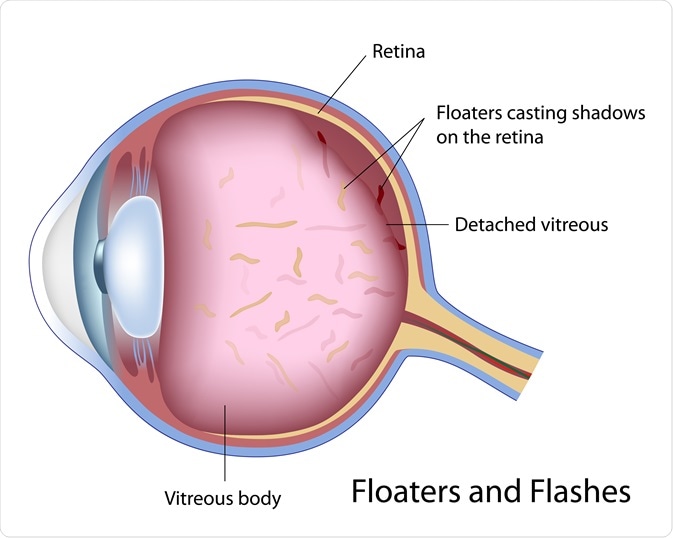Eye floaters (myodesopsias) emerge as a consequence of opacities developed in the vitreous fluid of the eye.
The fibers in the vitreous create shadows on the retina and these shadows are called floaters. Based on the size and shape of the fibers, floaters may appear as black spots, thread-like, or a small piece of cobweb.
When the eye moves, these fibers move in the vitreous fluid and become visible. Floaters are dark or semi-transparent and are visible while staring at a surface that is light-colored or when exposed to bright light. When we try to look at a floater, it will tend to move away in the direction in which the eye is being moved.
 Eye floaters showing whilst looking at a blue sky. Image Credit: meyerandmeyer / Shutterstock.com
Eye floaters showing whilst looking at a blue sky. Image Credit: meyerandmeyer / Shutterstock.com
Anatomy of vitreous
A human eye is comprised of 1) anterior chamber 2) vitreous chamber and 3) posterior chamber. The vitreous chamber covers approximately 80% of the eyeball. The vitreous humor or vitreous is a colorless fluid present in between the retina and lens in the eye.
Vitreous humor is comprised of 99% of water, and the remaining 1% is a mixture of collagen fibers, large molecules of hyaluronic acid, hyalocytes, inorganic salts, sugar, and ascorbic acid. The fluid has a gel-like consistency and helps to maintain the spherical shape of the eye. The pressure of the fluid is responsible for keeping the retina in position.
Posterior vitreous detachment
When the posterior vitreous cortex is separated from the internal limiting lamina of the retina, we term the condition as Posterior Vitreous Detachment (PVD).
Total PVD
At a young age, the vitreous will be a gel-like substance. As a person grows older, the vitreous gel will lose its gel-like property slowly. It becomes watery, losing its shape and detaches from the retina, eventually causing PVD. At this stage, patients may experience a cobweb-like or multiple-string type floaters. During the melting process of the gel, the floaters will usually settle down in the liquid and disappear. Some residues will still not settle and cause residual floaters.
Partial PVD
When the vitreous partially detaches from the retina, we term this as partial PVD. In these cases, the floaters may settle in the center of the eye’s vision or in the visual axis and creates a sharp shadow on the retina.
 Diagram of eye floaters. Image Credit: Alila Medical Media / Shutterstock.com
Diagram of eye floaters. Image Credit: Alila Medical Media / Shutterstock.com
Infection, injury and inflammation (uveitis) of the eyes
Injuries to eyes such as hit by blows (ball or elbow), fingernail scratches, exposure to chemicals, and penetration of foreign bodies such as small wood or metal or glass pieces can cause floaters.
Infection and injury to the eye can cause inflammation in the eye leading to uveitis. Retina, vitreous, lens, optic nerves are all affected resulting in floaters. The most common form of uveitis, anterior uveitis, may affect only a single eye whereas in the case of intermediate uveitis inflammation is seen in the vitreous.
Though posterior Uveitis is not common, it affects both the retina and the choroid. Pan-uveitis, the most severe form, damages the retina. All of these conditions favor the development of floaters.
Hemorrhage of the vitreous
The vascular endothelial growth factor, chemotactic factors, and medical conditions such as ischemia lead to neovascularisation, the formation of new blood cells. These abnormal retinal blood vessels lack endothelial tight junctions, which influence continuous bleeding and normal vitreous resistance when the eye moves and can rupture the vessels. Blood from sources adjacent to the vitreous can also result in vitreous hemorrhage. Patients may see tiny red floaters when blood is present in the vitreous cavity.
Retinal tears and vitreous detachment from retina
Ordinarily, light rays are converted to a brain-readable format by the retina. Sometimes the vitreous present in the middle of the eye may form gel clusters and create shadow effects on the retina, which could be a cause for floaters. When the vitreous shrinks and pulls the retina, patients can view flashes resembling something like a star. However, if the pull is very hard then the vitreous can even tear the retina, leading to retinal detachment and making floaters most common in these conditions.
Eye Floaters and Flashes, Animation.
Medical conditions
Patients who suffer from myopia – when one can see objects clearly if they are near but see them as blurry if they are far off - are prone to floaters.
In diabetes patients, vitreous glucose levels will rise and create fluctuations in metabolism. Within the vitreous, the ionic milieu may also be affected due to the changes in the molecular concentrations. These situations may perhaps be a cause for hemorrhage in the vitreous. Chronic hemorrhages lead to vitreous opacification and the opacities are degenerated; collagen is peripherally displaced.
Benign conditions, as in Asteroid Hyalosis, make the spherical shaped opacities spread in the vitreous and the asteroid bodies move when vitreous is displaced. In conditions such as Amyloidosis, the opacities initially appear adjacent to blood vessels of the retina. Later in the anterior vitreous, they look granular at first, then appear to be like a glass wool and may form strands when aggregated.
References